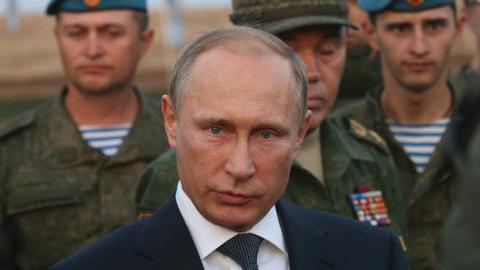A question haunts NATO, Europe, and U.S. policy-makers this week: Who can stop Putin? The short answer is: Only Putin can stop Putin — if he can be convinced that occupying more of Ukraine and pulling apart the Western alliance involve more costs than benefits.
The longer answer is: The solution isn’t in Washington or Brussels, or in Ukraine itself, but on Putin’s other borders, specifically his northern flank. The goal is to force Putin to realize that making Ukraine part of his empire won’t solve any problems but will only create new — and very dangerous — ones. Sweden and Finland offer an opportunity to make Putin see that he is overreaching and needs to stop.
As for Washington, it’s now very clear that this president can’t put the brakes on Putin. Set aside his disastrous press-conference remarks seeming to brush off a “minor incursion” by Russia into Ukraine and his calamitous withdrawal from Afghanistan. Biden’s feeble and erratic leadership of his own party here at home tells Putin that the person sitting in the Oval Office is no one to fear.
Our European allies realize this, which is why the countries of the Western alliance, especially Germany, already show signs of going wobbly on Ukraine. Meanwhile, the American public is uneasy about what’s unfolding along the Russia–Ukraine border, but not enough to rally around another American land war, this time in Eastern Europe.
The deterrent effects of economic sanctions against Putin and Russia are seriously overblown, as they usually are by diplomats, journalists, and democratic politicians. The notion that freezing or even emptying the bank accounts of Putin and his henchmen will make him change his plans seriously underestimates what’s unfolding. Besides, even if the West shut Russia out in terms of international trade, including natural-gas exports — which seems highly unlikely at this point — Putin and Russia have another economic outlet: China. The new economic order that Xi Jinping is busily building at our expense will have a privileged place for Russia, and likewise for Iran.
At the same time, the current scramble to send military-aid packages to Ukraine is too little, too late — and gravely overestimates Ukraine’s capacity for resisting a serious Russian invasion.
In fact no one can stop a dictator from going to war. One can only make peace look preferable.
My Hudson Institute colleague Walter Russell Mead has sensibly suggested turning to Russia’s southern flank and working with Turkey, which has a centuries-long fear of Russian dominance and which may be NATO’s most underappreciated asset.
The Nordic countries are an even better option. Offering them full membership in NATO will not only give them Article 5 security against any future Russian incursions along their border. It will give Putin something to worry about regarding his very vulnerable northern frontier. Don’t be misled by the assumption that because the Nordic countries are heavily invested in welfare-state politics they are somehow “soft” on defense, especially their own. Sweden has a modern, well-equipped military and is set to increase defense spending by 40 percent by 2025, the biggest increase in more than 70 years. Finland will soon reach NATO’s defense-spending guideline of 2 percent of GDP, a rate of military expenditures larger than Germany’s or Italy’s.
Finland had to fight two bloody wars of independence from Russia, after World War I and during World War II. Politicians in Helsinki know that if Ukraine falls under Moscow’s sphere of influence, they and the Baltic republics will be next on Putin’s hit list. Meanwhile, a 2015 Gallup survey showed that 74 percent of Finns are prepared to fight for their country, compared with 18 percent of Germans.
Sweden’s biggest worry is that Russia’s Baltic enclave at Kaliningrad (formerly Koenigsberg) has a growing military presence threatening Gotland Island, which is vital to Sweden’s air defense and naval operations. Giving Sweden NATO membership (a 2021 poll revealed that 46 percent of Swedes support joining NATO ) would allow Stockholm to address that worry and even reverse the region’s strategic controls in cooperation with Poland and Lithuania, who are full NATO members.
Furthermore, both the Finnish and Swedish militaries are interoperable with NATO forces and have conducted military exercises with NATO forces as well as joint projects in the Arctic. That is significant because, thanks to climate change, the Arctic is becoming the new strategic frontier for the U.S. and the free world. Widening the alliance this way would shift the balance of power in both the Arctic and Baltic Seas to the advantage of NATO’s northern tier, including the U.S., Canada, and Norway. Russian economic interests would look highly vulnerable, including Nord Stream 1 and 2, since both pipelines cross the Baltic Sea.
In short, offering to bring Finland and Sweden into NATO creates an entirely different and dangerous scenario for Vladimir Putin. Add in a strong approach to Turkey, and Putin will realize that by encircling and isolating Ukraine, he has triggered a different kind of encirclement in retaliation — one that threatens his long-term interests even more.
It would be too much to suggest that the Viking spirit will save NATO. But the leadership of NATO has been marching steadily northward and eastward, to Poland, Hungary, the Baltics, and Romania. Drawing in Sweden and Finland would only complete the process. It would be the key to turning NATO into a useful vehicle for meaningful strategic cooperation again, and for staying the Russian dictator’s hand at long last.
Read in National Review

















